Abánades
Abánades is a municipality located in the province of Guadalajara, Castile-La Mancha, Spain. According to the 2010 census (INE), the municipality had a population of 75 inhabitants.
Abánades, Spain | |
|---|---|
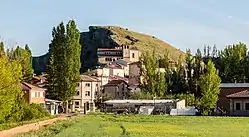 | |
 Flag 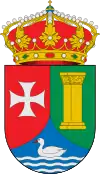 Seal | |
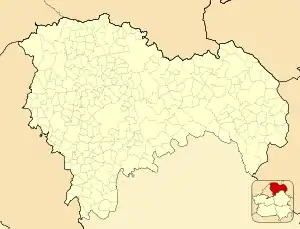 Abánades Location in Spain 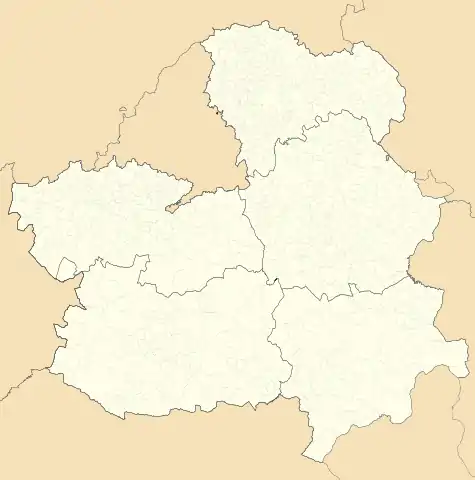 Abánades Abánades (Castilla-La Mancha) 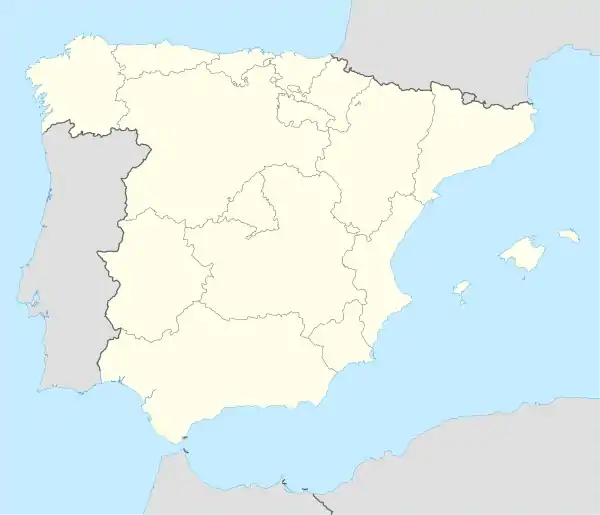 Abánades Abánades (Spain) | |
| Coordinates: 40°53′33″N 2°29′7″W[1] | |
| Country | |
| Autonomous community | Castile-La Mancha |
| Province | Guadalajara |
| Municipality | Abánades |
| Area | |
| • Total | 36.08 km2 (13.93 sq mi) |
| Elevation | 1,039 m (3,409 ft) |
| Population (2018)[2] | |
| • Total | 53 |
| • Density | 1.5/km2 (3.8/sq mi) |
| Time zone | UTC+1 (CET) |
| • Summer (DST) | UTC+2 (CEST) |
Demography
| 1991 | 1996 | 2001 | 2004 | 2006 | 2009 | |||||
|---|---|---|---|---|---|---|---|---|---|---|
| 128 | 125 | 114 | 107 | 97 | 83 |
Medieval history of Abánades
During the 10th century Abánades, already sufficiently developed, was located in a large area known as the Barusa, the upper limit of Al-Andalus, i.e. the border with the Northern Christian kingdoms. The Kingdom of León, which already had with its small independent county called Castile, and the Kingdom of Navarre, bordered Barusa. This area was of importance from the times of the Arab settlement in the Peninsula, because of the city of Medina Selim, Medinaceli. General Tarik had, in 712 reached Zaragoza with his Arab troops, after defeating the Visigoth King Roderic in Guadalete, and founded a medina - city - there on the ruins of the Roman city, abandoned during the later Empire.
It was not until the 10th and 11th centuries that Medinaceli became the military capital of the Marca Media, with leader Almanzor, retaining its strategic importance as a defensive fortress against the progress of the Christian kingdoms. In the 12th century, specifically in 1104, the Castilian King Alfonso VI and his captains reconquered the city, and with it, its zone of influence, which included the future community of Villa and Tierra de Medinaceli, with territories in Soria, Northern Guadalajara and part of Teruel. Although there are informational documentaries of Abánades up to the first year of the 14th century, by then it was already framed in the jurisdiction of Medinaceli, which suggests that it also belonged to that city under Arab rule.
10th and 11th centuries
Nothing or very little is known of the Arab population enclaves during the 10th and 11th centuries. It has been documented that many cities lost their population, migrating to safer areas, converting urban centers into military camps supplied from the people who were under their dominion. These villages, meanwhile, constituted the possessions of landowners of Arab origin, land given to farmers and Mozarabic merchants - Christians living in the Caliphate or Taifa kingdoms, who were still practicing their religion - the Jewish population, and non Arabic Muslims. When the territories were incorporated into the Christian possessions, Arab nobility was replaced by new Christian owners, who retained the mass Mozarabic populations, Jews and Muslims under their control. These populations were further enhanced with new settlers in depopulated areas.
12th century
In 1104 Alfonso VI reconquered Medinaceli,[4] and left Captain Gonzalo Núñez de Lara there as lieutenant, with complete freedom to organize the municipality. The repopulation did not start until fifty years later, when they managed to expel the Arabs from the Calatayud and Sigüenza regions. Of particular importance was the taking of the Segontin capital by Bishop D. Bernardo. However the complete conquest of the territory in which Abánades sits and its neighboring towns as far as La Torresaviñán was undertaken by Manrique Pérez de Lara, First Lord of Molina, whose domain extended into this area. In 1154 Manrique ceded this part of the lordship to the diocese of Sigüenza, which claimed its rights based on a document called the Hitación de Wamba (The division of Wamba). This document reflects the division of the dioceses effected during the times of Visigothic king Wamba, which lists the villages covered. Supposedly this 'hitación' was brought to Asturias with the Christian troops that survived after the Arab invasion. León still remains today.
Origin of Abánades
There is no documentary evidence of Abánades until the first year of the 12th century, when Peter I (the Cruel), King of Castile, mandated the carrying out of the Behetrías Bull, to find out all the people who were within the domain of the Castile crown. By means of a study by Gonzalo Martinez, the village communities and the land of Extremadura Castellana, historians have been able to discover the geographic location of the populations mentioned in the same Bull. Through these the existence of some disappeared populations, which remain as ruins in present municipalities, or whose existence has survived as a legend, were able to be discovered.
Late Middle Ages
Starting from 1350 the development of Abánades is clearer through studies by Maria Luisa Pardo Rodriguez into the Archives of the Dukes of Medinaceli in Seville. Through her it is known that the Dukedom of Medinaceli was given by King Henry II of Castile to Bernardo de Bearne, along with the title of count, in 1368.[5] From 1368-1392 he had 107 villages under his control, but due to the war with Aragon and personal incursions by Count Don Gastón de la Cerda there was significant depopulation in some areas, i.e. 44 villages disappeared. One of the villages that disappeared, Casares, now forms part of the municipality.
Monuments
Amount the more notable monuments is the Church of St. Peter, dating from the 16th century. There is also the Chapel of Our Lady of Mercy, another prominent building.
References
- "Archived copy". Archived from the original on 2011-10-03. Retrieved 2013-02-09.CS1 maint: archived copy as title (link)
- Municipal Register of Spain 2018. National Statistics Institute.
- "INEbase / List of place names". INE.
- Reilly, Bernard F. (1988). The Kingdom of León-Castilla Under King Alfonso VI, 1065-1109. Princeton University Press. p. 432. ISBN 0691055157.
- Javier Mozas Hernando. "Apellidos de Soria". Retrieved 19 February 2008.
